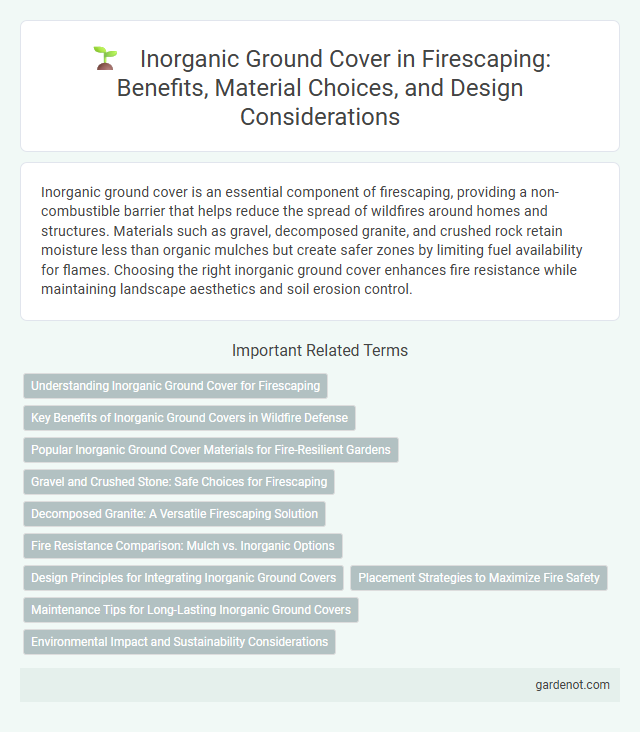Inorganic ground cover is an essential component of firescaping, providing a non-combustible barrier that helps reduce the spread of wildfires around homes and structures. Materials such as gravel, decomposed granite, and crushed rock retain moisture less than organic mulches but create safer zones by limiting fuel availability for flames. Choosing the right inorganic ground cover enhances fire resistance while maintaining landscape aesthetics and soil erosion control.
Understanding Inorganic Ground Cover for Firescaping
Inorganic ground cover, such as gravel, crushed stone, and decomposed granite, plays a crucial role in firescaping by reducing combustible materials near structures. These materials create fire-resistant zones that help prevent wildfire ignition and slow flame spread. Proper installation and maintenance of inorganic ground cover enhance its effectiveness in landscape fire mitigation.
Key Benefits of Inorganic Ground Covers in Wildfire Defense
Inorganic ground covers such as gravel, crushed stone, and decomposed granite create a non-combustible barrier that significantly reduces wildfire fuel near structures. These materials improve soil drainage and minimize erosion, enhancing landscape stability during fire events. Their durability and low maintenance requirements ensure long-term wildfire defense without the risk of igniting or sustaining flames.
Popular Inorganic Ground Cover Materials for Fire-Resilient Gardens
Popular inorganic ground cover materials for fire-resilient gardens include gravel, crushed stone, and decomposed granite, known for their non-flammable properties and excellent drainage. These materials reduce the accumulation of combustible debris, helping to create defensible spaces around homes in wildfire-prone areas. Using inorganic ground covers enhances fire resistance while maintaining landscape aesthetics and minimizing maintenance requirements.
Gravel and Crushed Stone: Safe Choices for Firescaping
Gravel and crushed stone serve as effective inorganic ground covers in firescaping by creating fire-resistant zones around properties. Their non-combustible nature reduces wildfire fuel, helping to slow fire spread and protect structures. These materials also enhance drainage and minimize soil erosion, promoting landscape stability in fire-prone areas.
Decomposed Granite: A Versatile Firescaping Solution
Decomposed granite serves as a highly effective inorganic ground cover in firescaping due to its excellent fire-resistant properties and permeability. This material reduces fuel load around structures while promoting proper drainage, minimizing erosion risks in fire-prone landscapes. Its natural appearance and durability make decomposed granite a versatile choice for creating defensible spaces that comply with fire safety regulations.
Fire Resistance Comparison: Mulch vs. Inorganic Options
Inorganic ground covers such as gravel, lava rock, and decomposed granite exhibit superior fire resistance compared to organic mulch options like wood chips or bark, which are combustible and can ignite easily. The non-combustible nature of inorganic materials reduces the risk of fire spreading near structures, making them an essential choice in fire-prone landscapes. Fire-resistant inorganic ground covers also require less maintenance since they do not decompose or create additional fuel loads over time.
Design Principles for Integrating Inorganic Ground Covers
Inorganic ground covers such as gravel, decomposed granite, and crushed rock provide effective fire-resistant barriers within firescaping designs by reducing combustible vegetation and enhancing defensible space. Design principles emphasize strategic placement around structures, pathways, and at the base of plants to minimize fire spread and improve fire suppression access. Proper layering and selection of particle size also contribute to erosion control and aesthetic integration while maintaining fire safety standards.
Placement Strategies to Maximize Fire Safety
Strategic placement of inorganic ground covers such as gravel, decomposed granite, or lava rock creates effective firebreaks that slow or stop the spread of wildfires near structures. Positioning these non-combustible materials within at least 30 feet of buildings reduces ignition risks by limiting combustible vegetation in high-risk zones. Combining inorganic ground cover with proper spacing and maintenance further enhances fire safety by minimizing fuel continuity and promoting defensible space.
Maintenance Tips for Long-Lasting Inorganic Ground Covers
Inorganic ground covers such as gravel, decomposed granite, and lava rock require minimal watering and are highly resistant to fire hazards, making them ideal for firescaping. To maintain their longevity, regular removal of debris and occasional raking prevent organic matter buildup that could compromise fire resistance. Periodic replenishment of materials and monitoring for weed growth ensure the inorganic ground cover remains effective and visually appealing over time.
Environmental Impact and Sustainability Considerations
Inorganic ground cover such as gravel, decomposed granite, and crushed rock offers excellent fire resistance, reducing wildfire fuel without decomposing or supporting vegetation growth. These materials minimize water usage and soil erosion, promoting sustainable landscape management in fire-prone regions. Selecting locally sourced inorganic ground cover decreases carbon footprint and supports environmental sustainability by conserving natural resources.
Inorganic ground cover Infographic

 gardenot.com
gardenot.com